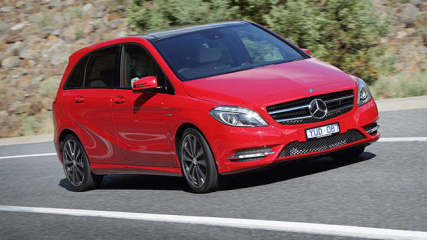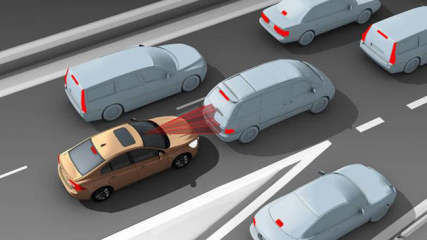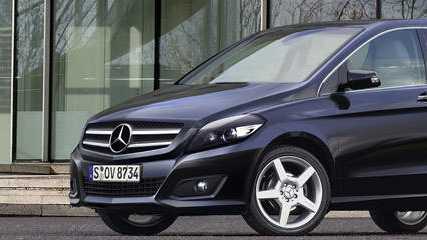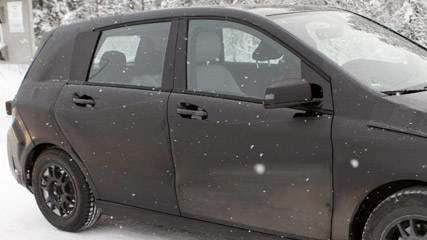Mercedes-Benz B250 2014 News

What are the safest cars?
Read the article
By Craig Duff · 13 Nov 2013
None of us wants to crash our shiny new car but, if we do, we want to know we're safe. That's where the Australian New Car Assessment Program's standardised crash-testing analysis is invaluable, providing comparable ratings for vehicles of all types.The ANCAP site notes that a one-star car is twice as likely to kill you as a five-star model. Carsguide examines ANCAP's results to find the best of breed in each segment. It's worth noting the advanced software in some cars that readies the vehicle if a crash is imminent are disabled during the official tests. Cars are scored out of 37 points after the following tests.FRONTAL OFFSET TEST: The subject vehicle is accelerated to 64km/h and rammed into a deformable alloy barrier to simulate a head-on crash. To increase the severity and reproduce real-world conditions only 40 per cent of the car hits the wall - equating to a driver swerving to avoid an oncoming vehicle.SIDE IMPACT TEST: The T-bone hit rams a 950kg trolley into the side of the car at 50km/h. The sled has an alloy face to simulate the front of another vehicle, which deforms and absorbs some of the impact.PEDESTRIAN TEST: Simulates the results of hitting a pedestrian at 40km/h. The test assesses adult and child impacts, given their heads and limbs strike different areas of the car.POLE TEST: This is the most demanding test in the ANCAP repertoire. Trees and poles don't deform, so all the crash energy is transferred to the vehicle. The car is put on a sled and propelled towards a fixed steel pole at 29km/h.SAFEST SMALL CARSAUDI A3 36.41 See reviews of this carOfficially the best small car to occupy in an accident. Impressively, the windscreen pillar didn't move after a 64km/h hit with the concrete block. HONDA INSIGHT 36.39 See reviews of this carIts score reflects a 3mm movement of the pillar in the frontal offset test and "slight risk" of serious leg injury for driver and passenger. BMW 1 SERIES HATCH 36.33 See reviews of this carThere's a slight risk of serious chest injury for the driver in the frontal and side crash test and a slight risk of serious leg injury for the passenger in the frontal crash. SAFEST MEDIUM CARSMERCEDES B-CLASS 36.78 See reviews of this carTops the charts with the highest score of any car in ANCAP database. Technically there's a 4mm movement of the front pillar and a slight risk of injury to the passenger leg closest the door. BMW 3 SERIES 36.76 See reviews of this carBarely behind. It showed a 1mm movement of the pillar and there was a slight risk of serious injury to the driver's and passenger's legs.VOLVO V40 36.67 See reviews of this carThe only loss of points occurred during the frontal crash test, with a slight risk of serious injury to the front occupants' legs closest the door and the driver's chest.SAFEST LARGE CARSTOYOTA AURION 36.59 See reviews of this carFirst place in this class makes it the only locally built vehicle in any top-three line-up. There's a slight risk of lower leg injury for driver and passenger. BMW 5 Series 36.53 See reviews of this carNot a bad place to be in the event of an accident either. It blitzed the side impact tests and only lost fractions of points in the head-on hit. VOLVO S60 36.34 See reviews of this carSweden maintains its safety credentials. The passenger compartment stayed intact with only a 1mm movement of the front pillar. SAFEST COMPACT SUVS SUBARU XV 35.53 See reviews of this carLike the slightly lower-riding Impreza, the XV scored highly in all crashes, with a slight risk of injury to the front occupants' chests and legs. HOLDEN TRAX 35.18 See reviews of this carThe surprise packet. One of the smaller cars in the class has only a slight risk of serious leg injury for those in the front in a head-on crash. Skoda Yeti 34.67 See reviews of this carDepite being one of the older examples in this segment, the Yeti still rates well for safety, with only a slight risk of serious leg injury for those in the front in a head-on crash. SAFEST MEDIUM SUVSVOLVO XC60 36.53 See reviews of this carANCAP says the cabin 'held its shape extremely well" in the frontal test, with the pillar shifting just 3mm. There was a slight risk of serious chest and leg injuries to the driver. FORD KUGA 36.33 See reviews of this carA solid second, posing a slight risk of serious chest injury for both front seat occupants. The front pillar moved 15mm. HONDA CR-V 35.91 See reviews of this carPlaced well despite being penalised for the foot-operated park brake moving upwards and back. Structurally there was only a 2mm movement of the pillar. SUBARU FORESTER 35.64 See reviews of this carTested this year, it scored highly in all crashes, with a slight risk of injury to the front occupants' chests and legs. SUBARU OUTBACK 35.52 See reviews of this carFills the brand's quinella. Crashed in 2008 and at the time topped the charts as the safest vehicle ANCAP had tested. SAFEST LARGE SUVSMERCEDES-BENZ ML 36.34 See reviews of this car Luxury SUV has a slight risk of serious chest injury for driver and passenger in the head-on hit and a slight risk of serious leg injury for the passenger. The pillar moved 2mm. RANGE ROVER 36.19 See reviews of this carBig Brit has a slight risk of serious chest injury for the driver and the pillar shifted by 15mm. NISSAN PATHFINDER 35.73 See reviews of this carSlight risk of serious leg injury for the driver. Unlike the other two, it applies to the upper leg as well as the expected lower-leg hits. Docked points for a marginal pedestrian impact result.

Auto braking will save lives and money
Read the article
By Craig Duff · 07 Aug 2012
Autonomous braking systems could save 250 lives and around $5 billion a year, according to Australia’s vehicle crash-testing body.Australian New Car Assessment Program chief executive Nicholas Clarke said automated emergency braking systems are the “next big thing” for vehicle safety.“AEB can probably be considered the next seat belt or electronic stability control equivalent in terms of saving lives,” Clarke said. “Advanced safety assist technology can help remove the weakest link when it comes to car crashes; the driver. “If every car on the road was equipped with AEB, the toll would fall by around 25 per cent.”Many carmakers already offer models with automated braking systems. The cheapest is the Volvo V50 wagon, which is priced from $42,990. Ford’s $33,840 Focus Titanium and the $38,950 Mercedes-Benz B-Class can both be optioned with the technology, costing $2300 and $2500 respectively.AEB systems use video cameras, radars or lasers to scan the road and determine the distance to the vehicle ahead and its relative speed. When the AEB-equipped vehicle gets too close, the software sounds a warning and then actively engages the brakes if the driver fails to respond.Australia was the first country to legislate compulsory seat belt use in 1970-’72. Global motoring body, the FIA, says wearing seat belts has reduced fatalities by 20 per cent in Australia since that date. Federal Department of Infrastructure and Transport figures state the economic impact of the 1288 deaths last year was around $27 billion.ANCAP’s “road map” of technologies required in future cars lists AEB as an optional system for five-star certification by 2017. Clarke expects to have that date revised down _ and predicts it will be mandatory, rather than optional. “We’re already talking to carmakers and lobbying the federal government to introduce these systems as soon as possible,” he said.Pedestrian Council of Australia head Harold Scruby is an enthusiastic supporter of the safety technology but doesn’t expect to see any quick action from the government. “I’ve actually been to see Catherine King pleading with her to mandate rear-vision cameras, which would cost about $100 a vehicle,” he said.“Unfortunately, this seemed to fall on deaf ears. If we can’t get reversing cameras mandated, what hope have we got getting this technology into the Australian Design Rules?” Drivers who buy cars with the technology should also benefit from lower insurance premiums, with some companies offering up to 20 per cent off the regular premium for AEB-equipped models.AEB EXPLAINEDAutonomous emergency braking systems use video cameras, radar or lasers to scan the road ahead and assess the vehicle’s speed as well as the speed of the car in front. Most warn the driver in the approach speed is too high and then automatically apply the brakes if an impending nose-to-tail crash is detected.Depending on the situation, the systems can either prevent an accident outright or dramatically cut the severity of the impact - and therefore the damage to the vehicles and occupants. There is no industry standard for the software. As a result, three differing versions are now sold. The first works at typical city speeds of below 30km/h; others operate at highway speeds. Finally, some systems also detect and react to pedestrians walking out into the vehicle’s path.

Spy Shot Mercedes-Benz B-Class
Read the article
By Paul Gover · 15 Apr 2010
Mercedes-Benz is out to revitalise and re-invent its boxy B-Class with an all-new model aimed directly at the winner of the Carsguide and World car of the year awards over the past 18 months.The new B is also expected to spark a range of spin-off models including a curvy new coupe similar to a scaled-down Benz CLS, as well as a compact SUV. The Carparazzi crew has been on the case and, as well as catching the B-Class during development trials, has stripped away the on-the-road camouflage panels for a peek at how the new contender is likely to look.It has created a picture of a B-Class that is a lot less boxy than today's compact, but still with a mini-wagon look which should work for people shopping it against baby SUVs including the latest BMW X1. The B will have a big job in Australia as Mercedes is planning to dump its smallest model, the A-Class, and using the new baby B as its local lead-off once buyers step up from the Smart class.Globally, Benz is aiming to substantially lower the age of existing B- Class owners - who are mostly in the 60-plus retirement bracket. Carparazzi says the new B-Class will be pitched as a sports-tourer in Europe to compete with the Golf, although little is known about potential powerplants beyond the need for a hybrid alongside the regular petrol and BlueEfficiency diesels.

Spy shot Mercedes-Benz B-Class
Read the article
By Paul Gover · 11 Feb 2010
It's a road-up rework of the compact B-Class and it should be in Australia in 2011. The new B is being tested in snowy conditions in Scandinavia under heavy disguise, but early details have already emerged.For at start, in Australia the new B will signal the end of sales of the baby A-Class. The two cars have competed for similar customers in recent years and Mercedes-Benz should confirm a future push that is built around the B-Class car.The design of the new B, according to Carparazzi sources in Europe, will be much less boxy and more like the hatchbacks fielded by everyone from Audi and Ford to Volkswagen.It will still have a high seating position and a multi-function cabin, but the overall look will be very different and more youthful. The objective is to win younger buyers, and not just the middle-aged empty nesters and 60-plus retirees that currently chose the B-Class. And the Golf is the target. Mercedes clearly plans to make the car a Golf beater and that also means the 2011 B-Class will have super-efficient petrol and diesel engines, but further into the future the car is also expected to be built as a petrol-electric hybrid and then - with the Smart as the focus for plug-in electric motoring - a fuel cell car powered by hydrogen.




